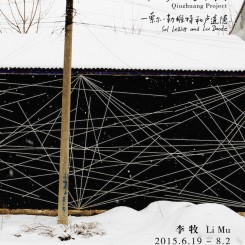Title: Qiuzhuang Project:Sol LeWitt and Lu Daode
Artists: Li Mu
Curators: Davide Quadrio(乐大豆)、Charles Esche(查尔斯˙埃申)
Exhibition Period: June 19 – August 2, 2015
Opening Event: 19:00-20:30, June 19, 2015 (Sat.)
Venue: 1F Gallery, Aurora Museum
Organizer: Aurora Museum
Add: No. 99, Fu Cheng Road, Pudong District, Shanghai
Opening hours: 10:00-17:00 from Tuesday to Sunday. Fridays open until 21:00(Closed on Mondays)
Tel:021-58408899-607
Website:http://www.auroramuseum.cn
Exhibition Introduction:
“Qiuzhuang Project” (2012.01-2013.07), is a long-term intervention piece that Li Mu produced in his hometown. The main focus was about reproducing and exhibiting important works from the Van Abbemuseum in the Netherlands. 10 artworks by 8 artists were personally selected by Li Mu with the following criteria: first, the work could have a connection to the village, and second, the work could build a new connection with the village. In the process of creating this work, he did not mean to instill Western culture on the local villagers, but rather create a new environment in which they could experience art. Li Mu has managed to use his art, knowledge, and experience to establish relationships within his village to foster development and influence.
The topic chosen for the current exhibition is an “encounter” between Lu Daode and Sol LeWitt. Li Mu invited the village’s old painter, Lu Daode, to reproduce two wall paintings by Sol LeWitt (Wall Drawing No. 256, Wall Drawing No. 480). Audience can see the records of the production process, and interview videos of Lu Daode’s, as well as daily reports of the program during “Qiuzhuang Project.”
About the Artist
Li Mu, born 1974 in Jiangsu Province, studied at Tsinghua University’s Academy of Art, lives and works out of Suzhou and Shanghai, was a finalist for the CREDIT SUISSE Today Art Award in 2011, and was given residency at New York’s ISCP (International Studio & Curatorial Program) by the Asian Cultural Council (ACC) in 2012. His art practice focus on video installation and performance art. From 2008 to 2009 he worked on “The Blue Books,” a project that aimed to spread artistic influence among teenagers. In 2010, collaboration between the Shanghai World Expo and the Van Abbemuseum in Eindhoven produced the exhibition “Double Infinity” that gave rise to “Qiuzhuang Project”.
Lecture: Art for the People: Qiuzhuang Project and the History of Rural-based Projects in Contemporary Chinese Art
Speaker: Madeline Eschenburg(Ph.D Student at the University of Pittsburgh)
Time: 14:00 – 16:30, July 18, 2015 (Sat.)
Venue: Multi-function Hall (1F, Aurora Museum)
Introduction:Since the middle of the 20th century the relationship between the artist and rural China has undergone many changes. This can be seen by examining how the rural person is depicted, approached, or integrated as subject matter or fellow collaborator. Since the 1990s, the cultural and economic divide between the urban and rural has only become more pronounced. In response to this, and in some ways continuing the revolutionary tradition, some contemporary artists have continued to make art about, for, or with rural China. As one of these artists, Li Mu has taken a unique approach to the countryside, engaging with inhabitants of his home town to recreate famous works of modern art from the Van Abbemuseum in the Netherlands. By historically situating Li Mu’s Qiuzhuang Project within the context of contemporary art projects in the countryside since the late 1970s, this lecture will explore its greater significance in the history of contemporary Chinese art.

